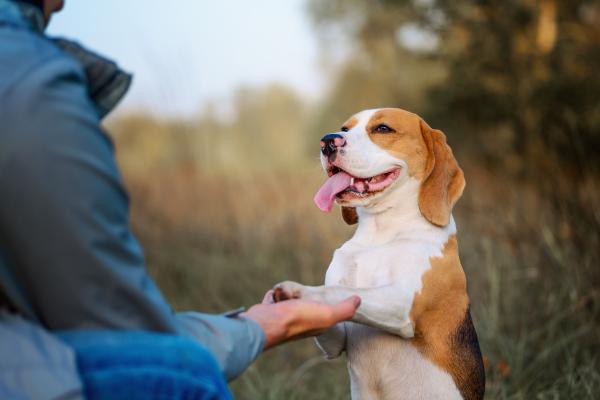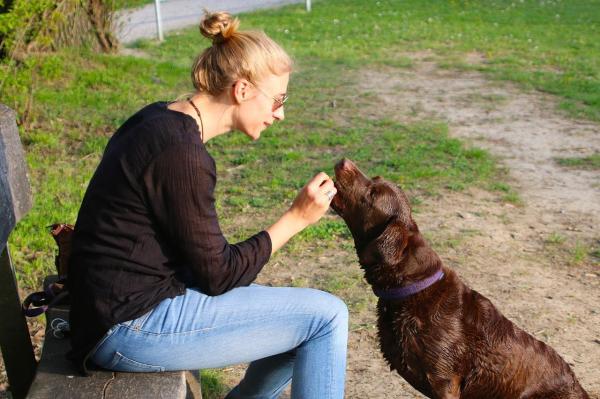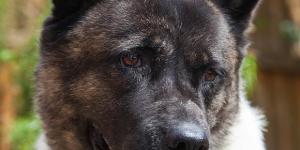Basic Dog Training Commands



See files for Dogs
Basic dog training commands are the orders which guardians use to ensure that canines and humans can coexist within the family. Some people think that dog training is about teaching our dog tricks, but this is secondary education for dogs. Primary education requires training which will help to establish boundaries in the home. For example, we will start with potty training so that they do not urinate or defecate outside. The purpose of basic dog training commands is to use orders that are helpful in ensuring the dog's safety. We can then build upon this commands for more specific or advanced training.
At AnimalWised, we explain what are the basic dog training commands for puppies and dogs. In doing so, you can use these commands to facilitate more advanced training which we also discuss.
Why are basic dog commands important?
Basic dog training commands serve several essential purposes when educating your puppy or adult dog. When we adopt a dog into the home, there will be a process of adaptation as they learn about and adjust to their new environment. A well-adjusted dog will be happy and healthy, but it will also allow a better relationship between guardian and companion animal. The following are reasons why basic dog training commands are so important:
- Communication: basic commands for dogs establish a common language of communication between the dog and guardian. This helps convey expectations and allows the owner to communicate their desires and instructions effectively.
- Safety: basic commands such can be critical for the safety of the puppy and others. They can prevent the dog from running into traffic, approaching dangerous situations or being exposed to potentially harmful objects or substances.
- Behavior management: training commands are essential for managing and modifying a dog's behavior. Commands like ‘down’ or ‘leave it’ can be used to discourage undesirable behaviors such as jumping on people, chewing inappropriate objects or even aggressive tendencies. Learn more about the different types of aggression in dogs.
- Socialization: training commands promote positive social interactions. A well-behaved dog is more likely to be accepted in various social settings, including public places, parks, and around other animals and people.
- Bonding and trust: training enhances the bond and trust between the dog and their guardian. Consistency, structure and positive reinforcement allow dogs to thrive and training provides opportunities for positive interaction and reinforcement.
- Mental stimulation: learning and performing commands stimulate a puppy's mental faculties and keep their minds active. Mental stimulation is just as important as physical exercise for a dog's overall well-being.
- Confidence building: successfully learning and following commands can boost a dog's confidence and sense of accomplishment. This can help reduce anxiety and increase a dog's overall happiness.
- Preparation for advanced training: basic dog training commands lay the foundation for more advanced training. These include obedience training, agility or specialized work like search and rescue or service dog tasks.
- Problem prevention: by teaching commands like ‘off’ or ‘quiet’, owners can prevent common behavioral problems from developing, such as jumping on guests or excessive barking.
- Improved quality of life: a well-trained puppy is often more relaxed, well-adjusted and easier to live with. This contributes to a higher quality of life for both the dog and its owner.
Basic dog training commands are fundamental for fostering a positive, safe and harmonious relationship between dogs and their owners. They provide structure, communication and guidance. Now we know why they are important, you can find out what are the most important basic dog training commands below:
Sit
The first thing to teach a dog is how to sit. It is the easiest basic command to teach since it is something the puppy will be naturally inclined to do. Even before training, you may see them sit in front of you when they see you with food. This is because they want to show you they are a good dog and should be rewarded. This does not mean they will naturally know what the command ‘sit’ means. This is why we need to use the following steps:
- Take a treat or reward for your dog. Let the dog smell it and then wrap it in a closed fist.
- Stand in front of your dog while they pay attention to you expecting to receive the treat.
- Say to the dog ‘[name], sit!’ or ‘[name], sit down!’ Use whichever you prefer.
- With the dog's attention fixed on the fist, begin to follow an imaginary line toward the back of the dog, going over their head.
At first the dog will not understand. They may try to turn or move around, but persevere until they sit still. Once they do this, you can reward them with the treat while saying something reassuring such as ‘good boy!’
You can use any word you want to teach the order, just keep in mind that dogs tend to remember simple words more easily. Once you select the basic command word, you should always use the same one. Consistency is very important in all dog training, especially with puppies learning for the first time.

Stay
Your puppy must learn to stay still in the same place. This is important for their safety, as well as being for the benefit of others in the home. For example, if a dog is being inquisitive with a stranger, we can command them to stay still so they don't bother them. Use the following steps to command a dog to stay:
- When your dog is sitting, stand next to them to the left or right. Put the leash on their harness and say ‘[name], stay!’. As you do so, place the palm of your open hand near the dog. Wait a few seconds and repeat if they manage to stay in the same place. If they stay put, you can reward them with a treat and some affection.
- Repeat the same process until they stay still for more than 10 seconds. Remember to always reward them with a treat and encouraging words at first. You can then alternate between a treat and encouragement alone, eventually phasing treat out altogether.
- When you can get your dog to remain still give the order and move away. If they follow you, move close to give the order again. Move a few meters away, call them to you and then provide a treat.
- Start increasing the distance until your dog until you are 10-15 meters (30 to 50 feet) away. Always remember to call at the end and say ‘come here!’ or something similar so they know when they can move.
Down
As with sitting, getting a puppy to lie down is a similar basic dog training command which is easy for them to learn. It is also a progression of the former command since dogs may sit first and then be commanded to lie down. The dog will quickly associate this and be much more likely to carry it out again in the future automatically:
- Choose a quiet environment
- Gather treats your dog loves
- Start in the ‘sit’ position
- Hold a treat close to your dog's nose in an enclosed hand
- Lower the treat to the ground and say ‘down’
- Reward and praise when your dog lies down
- Repeat, gradually reducing treats
- Practice in short, positive sessions for consistency
If you use the trick of putting a treat in your hand you must gradually withdraw this element so the dog learns to lie down even without the treat.
Heel
We do not want our dog to escape, not listen to us or not come when called. This is why training a dog to respond to the command ‘come here’ is very important. It not only helps us to control our dog, but it best ensures their safety because we can call them when they are headed somewhere there is potential danger. The following is how to teach a dog to come:
- Begin in a secure, enclosed area to prevent escape
- Get your dog's attention by calling their name
- Use the verbal cue ‘come here’ or simply ‘come’
- Crouch down, open your arms and offer encouragement
- When your dog approaches, reward with treats and praise
- Avoid scolding if your dog is slow to respond
- Practice to reinforce recall.
Remember to reward the puppy when they complete these basic orders, positive reinforcement is the best way to educate a dog or any other animal.

Heel
Pulling on the leash is a common problem when going for a walk. We can make the dog come, sit and lie down, but as soon as we get moving again the only thing it does is start pulling again to smell or try to catch something. This is the trickiest part in this guide to basic dogs training, but with patience we can get the dog to walk with us.
- Choose a quiet environment
- Start with your dog on a leash and in a sitting position
- Hold a treat in your hand at your side
- Begin walking, keeping your dog on your left side
- Use the verbal cue ‘heel’ and start walking
- Reward and praise when your dog walks calmly beside you
- Use treats consistently to reinforce the behavior
- Practice to improve leash manners
Learn more with our article on how to train a dog to stop pulling on the leash.
Other more advanced commands for dogs
Although the above mentioned are the basic commands that every owner must know to start properly educating their dog, there are other more advanced level commands we can start practicing once the first set have been internalized.
- Fetch: this command is used in canine obedience to receive something. For example, if we want to teach our dog to bring the ball or a toy it is essential to teach it both the command ‘fetch’ as well as ‘bring’ and ‘let go’.
- Jump: especially for those dogs that have agility practice, the order ‘jump’ will help them get over a fence, wall or whatever obstacle upon the owner's command.
- Forward: this command can be used with two different purposes, either to indicate the dog should run forward or as a release order so the dog knows they should top doing whatever activity in which they are occupied. As the most common is the first former, we can also replace the command word with another word such as ‘go’.
- Find: as we have discussed, this basic dog training command can be used to track an object that you have thrown or hidden somewhere in the home. With the first option we will keep the dog active, entertained and above all free from tension, stress and pent-up energy. With the second we will stimulate its mind and smell.
- Let go: with this order our dog will return the object it found and brought back. Although it may seem that ‘find’ and ‘fetch’ is enough, teaching the dog to release the ball will help us avoid having to remove the toy ourselves and will therefore allow us to have a calmer companion.
If you think you might need some more help with your dog's education, you should know that it is always possible to seek professional help. Canine ethologists and dog trainers can assess your dog's individual needs and create a training program which will be tailored to them specially.

Positive reinforcement
As specified in each of the basic commands for dogs, positive reinforcement is always the key to getting the dog to internalize these basic dog training commands and enjoy themselves while playing with us. You must never punish the dog in a way that causes physical or psychological harm. Only use a firm ‘no’ when stopping an unwanted behavior. Also, any abuse used during the training sessions will be counterproductive and only result in your dog becoming stressed.
You must have patience to teach your dog basic commands as this can not be done in a day or two. This basic training will make them more comfortable when you go out for walks and avoid improper actions with other dogs, animals from other species and people. If you have any questions or want to add to the mentioned points some special techniques that you know about, leave a comment at the end of our article.

If you want to read similar articles to Basic Dog Training Commands, we recommend you visit our Basic education category.








